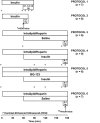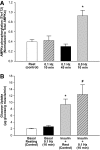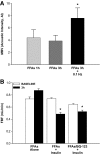Muscle contraction, but not insulin, increases microvascular blood volume in the presence of free fatty acid-induced insulin resistance
- PMID: 19675134
- PMCID: PMC2768172
- DOI: 10.2337/db08-1077
Muscle contraction, but not insulin, increases microvascular blood volume in the presence of free fatty acid-induced insulin resistance
Abstract
Objective: Insulin and contraction each increase muscle microvascular blood volume (MBV) and glucose uptake. Inhibiting nitric oxide synthase blocks insulin's but not contraction's effects. We examined whether contraction could augment the MBV increase seen with physiologic hyperinsulinemia and whether free fatty acid (FFA)-induced insulin resistance differentially affects contraction- versus insulin-mediated increases in MBV.
Research design and methods: Rats were fasted overnight. Plasma FFAs were increased by intralipid/heparin infusion (3 h), insulin was increased with a euglycemic clamp (3 mU x min(-1) x kg(-1)), and hindlimb muscle contraction was electrically stimulated. Muscle MBV was measured using contrast-enhanced ultrasound. Insulin transport into muscle was measured using (125)I-insulin. BQ-123 (0.4 mg/h) was used to block the endothelin-1 (ET-1) receptor A.
Results: Superimposing contraction on physiologic hyperinsulinemia increased MBV within 10 min by 37 and 67% for 0.1 or 1 Hz, respectively (P < 0.01). FFA elevation alone did not affect MBV, whereas 0.1 Hz stimulation doubled MBV (P < 0.05) and increased muscle insulin uptake (P < 0.05) despite high FFA. Physiologic hyperinsulinemia during FFA elevation paradoxically decreased MBV (P < 0.05). This MBV decrease was reversed by either 0.1 Hz contraction or ET-1 receptor A antagonism, and the combination raised MBV above basal.
Conclusions: Contraction recruits microvasculature beyond that seen with physiologic hyperinsulinemia by a distinct mechanism that is not blocked by FFA-induced vascular insulin resistance. The paradoxical MBV decline seen with insulin plus FFA may result from differential inhibition of insulin-stimulated nitric oxide-dependent vasodilation relative to ET-1 vasoconstriction. Our results implicate ET-1 as a potential mediator of FFA-induced vascular insulin resistance.
Figures







Similar articles
-
Salsalate attenuates free fatty acid-induced microvascular and metabolic insulin resistance in humans.Diabetes Care. 2011 Jul;34(7):1634-8. doi: 10.2337/dc10-2345. Epub 2011 May 26. Diabetes Care. 2011. PMID: 21617098 Free PMC article.
-
Free fatty acids induce insulin resistance in both cardiac and skeletal muscle microvasculature in humans.J Clin Endocrinol Metab. 2011 Feb;96(2):438-46. doi: 10.1210/jc.2010-1174. Epub 2010 Nov 3. J Clin Endocrinol Metab. 2011. PMID: 21047922 Free PMC article. Clinical Trial.
-
Contraction stimulates nitric oxide independent microvascular recruitment and increases muscle insulin uptake.Diabetes. 2007 Sep;56(9):2194-200. doi: 10.2337/db07-0020. Epub 2007 Jun 11. Diabetes. 2007. PMID: 17563063
-
Role of insulin in the pathogenesis of free fatty acid-induced insulin resistance in skeletal muscle.Endocr Metab Immune Disord Drug Targets. 2007 Mar;7(1):65-74. doi: 10.2174/187153007780059423. Endocr Metab Immune Disord Drug Targets. 2007. PMID: 17346204 Review.
-
Free fatty acids-the link between obesity and insulin resistance.Endocr Pract. 2001 Jan-Feb;7(1):44-51. doi: 10.4158/EP.7.1.44. Endocr Pract. 2001. PMID: 11250769 Review.
Cited by
-
Muscle microvasculature's structural and functional specializations facilitate muscle metabolism.Am J Physiol Endocrinol Metab. 2016 Mar 15;310(6):E379-87. doi: 10.1152/ajpendo.00443.2015. Epub 2015 Dec 29. Am J Physiol Endocrinol Metab. 2016. PMID: 26714849 Free PMC article. Review.
-
Interplay of fatty acids, insulin and exercise in vascular health.Lipids Health Dis. 2025 Jan 7;24(1):4. doi: 10.1186/s12944-024-02421-5. Lipids Health Dis. 2025. PMID: 39773723 Free PMC article. Review.
-
Glucagon-like peptide 1 recruits microvasculature and increases glucose use in muscle via a nitric oxide-dependent mechanism.Diabetes. 2012 Apr;61(4):888-96. doi: 10.2337/db11-1073. Epub 2012 Feb 22. Diabetes. 2012. PMID: 22357961 Free PMC article.
-
Adiponectin and insulin cross talk: the microvascular connection.Trends Cardiovasc Med. 2014 Nov;24(8):319-24. doi: 10.1016/j.tcm.2014.08.001. Epub 2014 Aug 7. Trends Cardiovasc Med. 2014. PMID: 25220977 Free PMC article. Review.
-
Vascular function, insulin action, and exercise: an intricate interplay.Trends Endocrinol Metab. 2015 Jun;26(6):297-304. doi: 10.1016/j.tem.2015.02.002. Epub 2015 Feb 23. Trends Endocrinol Metab. 2015. PMID: 25735473 Free PMC article. Review.
References
-
- Miles PD, Levisetti M, Reichart D, Khoursheed M, Moossa AR, Olefsky JM: Kinetics of insulin action in vivo. Identification of rate-limiting steps. Diabetes 1995;44:947–953 - PubMed
-
- Baron AD: Hemodynamic actions of insulin. Am J Physiol 1994;267:E187–E202 - PubMed
-
- Rattigan S, Clark MG, Barrett EJ: Hemodynamic actions of insulin in rat skeletal muscle: Evidence for capillary recruitment. Diabetes 1997;46:1381–1388 - PubMed
-
- Vincent MA, Clerk LH, Lindner JR, Klibanov AL, Clark MG, Rattigan S, Barrett EJ: Microvascular recruitment is an early insulin effect that regulates skeletal muscle glucose uptake in vivo. Diabetes 2004;53:1418–1423 - PubMed
MeSH terms
Substances
Grants and funding
LinkOut - more resources
Full Text Sources
Medical
Research Materials
Miscellaneous

